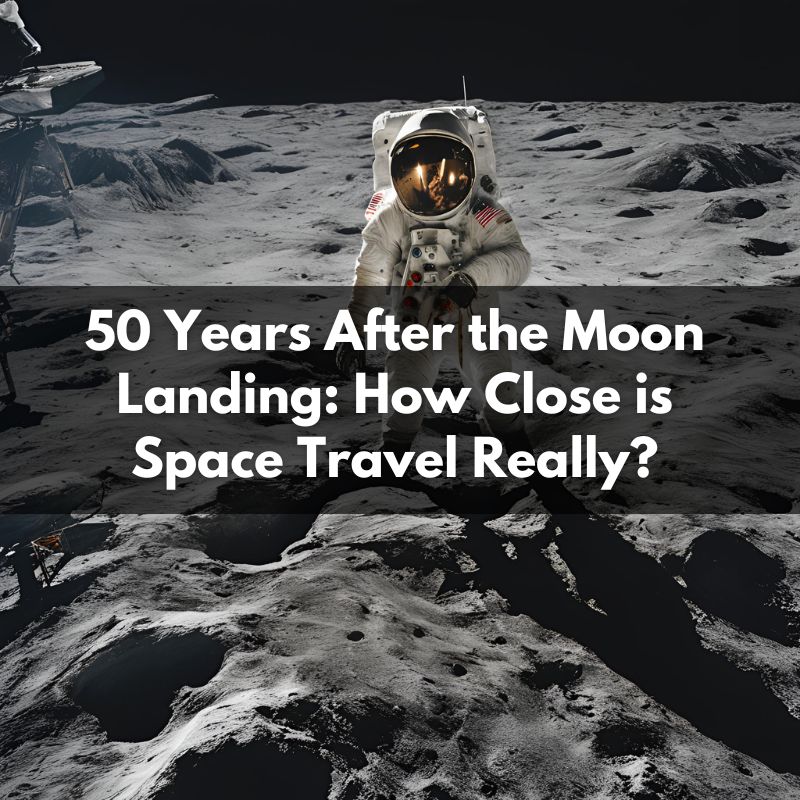
As we commemorate the 50th anniversary of the historic Apollo 11 Moon landing, it’s a fitting moment to reflect on how far space travel has come and how close we are to achieving new frontiers. Fifty years ago, humanity took its first giant leap beyond Earth’s atmosphere, igniting a passion for exploration that continues to drive advancements in space technology today. This milestone invites us to examine the current state of space travel, the advancements that have been made, and the ambitious plans that promise to take us even further into the cosmos.
The Legacy of Apollo 11
On July 20, 1969, Neil Armstrong and Buzz Aldrin became the first humans to set foot on the Moon, marking a monumental achievement in human history. The Apollo 11 mission not only demonstrated the possibilities of space travel but also inspired generations to dream beyond the confines of our planet. The success of Apollo 11 paved the way for subsequent missions, fostering advancements in technology, engineering, and international cooperation in space exploration.
The Evolution of Space Travel
Since the Apollo missions, space travel has undergone significant transformations. The initial focus on lunar exploration has expanded to include a broader range of objectives, from building space stations to exploring Mars and beyond. The establishment of the International Space Station (ISS) in 1998 marked a new era of collaboration, bringing together space agencies from around the world to conduct scientific research and develop technologies crucial for long-term space habitation.
The Rise of Private Space Companies
One of the most significant developments in recent years has been the emergence of private space companies. Companies like SpaceX, Blue Origin, and Virgin Galactic have revolutionized the space industry by introducing reusable rockets, reducing the cost of launches, and making space travel more accessible. SpaceX’s Falcon and Starship rockets, for example, are designed to carry humans to the Moon, Mars, and beyond, while Blue Origin’s New Shepard and New Glenn aim to facilitate both suborbital and orbital travel.
These private enterprises have not only accelerated technological advancements but have also sparked increased interest and investment in space exploration. Their innovative approaches and ambitious goals are reshaping the landscape of space travel, making it more feasible and sustainable for future generations.
NASA’s Artemis Program
NASA’s Artemis program represents a bold step forward in humanity’s quest to return to the Moon and establish a sustainable presence there. Scheduled to land the first woman and the next man on the Moon by the mid-2020s, Artemis aims to create a foundation for future missions to Mars. The program focuses on developing new technologies, building the Lunar Gateway space station, and fostering international partnerships to ensure the success and sustainability of lunar exploration.
Artemis not only seeks to revisit the Moon but also to utilize it as a stepping stone for deeper space exploration. By establishing a permanent human presence on the Moon, NASA hopes to pave the way for missions to Mars and other distant destinations, pushing the boundaries of what is possible in space travel.
International Efforts and Collaborations
Space exploration is no longer the sole domain of a few superpowers. Countries like China, India, and members of the European Space Agency (ESA) are making significant strides in their space programs. China’s Chang’e missions have successfully landed on the Moon and Mars, showcasing the country’s growing capabilities in space exploration. India’s Mars Orbiter Mission (Mangalyaan) and its plans for a human spaceflight program further highlight the global expansion of space travel efforts.
International collaborations are also becoming more common, with space agencies partnering on projects like the Lunar Gateway and joint missions to explore the Moon and Mars. These partnerships not only pool resources and expertise but also foster a spirit of global cooperation, essential for tackling the complex challenges of deep space exploration.
Technological Advancements Driving Space Travel
Technological innovation is at the heart of progress in space travel. Advances in propulsion systems, life support, and materials science are making longer and more ambitious missions possible. Reusable rocket technology, pioneered by companies like SpaceX, has significantly lowered the cost of access to space, making frequent launches more economically viable.
Additionally, developments in artificial intelligence and robotics are enhancing our ability to explore and utilize space environments. Autonomous systems and robotic explorers can perform tasks in harsh conditions, reducing the risks to human astronauts and expanding our capacity to conduct research and gather data from distant celestial bodies.
Space Tourism: The Next Frontier
Space tourism is rapidly moving from science fiction to reality. Companies like Virgin Galactic and Blue Origin are already offering suborbital flights to private individuals, while SpaceX is developing plans for orbital tourism and even missions around the Moon. These ventures are opening up space travel to a broader audience, allowing more people to experience the wonder of space firsthand.
While space tourism is still in its early stages, it holds the promise of creating new opportunities for commercial space activities and fostering a greater public interest in space exploration. As technology continues to advance and costs decrease, space tourism is expected to become more accessible, further driving the expansion of human presence in space.
The Road to Mars and Beyond
Mars has long been the ultimate goal for space exploration, and significant progress is being made toward making human missions to the Red Planet a reality. NASA, SpaceX, and other organizations are developing the necessary technologies to support long-duration space travel, life support systems, and sustainable habitats on Mars.
SpaceX’s Starship, for instance, is designed to carry large numbers of people and cargo to Mars, with the ambitious vision of establishing a self-sustaining colony. NASA’s Perseverance rover and the upcoming Mars Sample Return mission are laying the groundwork for future human exploration by studying the planet’s geology, climate, and potential for life.
Beyond Mars, the possibilities for space travel are limitless. Concepts like asteroid mining, deep space habitats, and even interstellar travel are being explored, pushing the boundaries of human ingenuity and ambition. While these goals may seem distant, the rapid pace of technological advancement suggests that the dream of exploring beyond our solar system may one day become a reality.
Overcoming Challenges
Despite the tremendous progress, space travel still faces significant challenges. The high costs associated with launching and sustaining missions remain a major barrier, although the advent of reusable rockets and increased competition among private companies are helping to mitigate these expenses.
Safety is another critical concern. Space travel involves inherent risks, from exposure to radiation to the dangers of re-entry and landing. Ensuring the safety of astronauts and future space tourists requires continuous advancements in technology and rigorous testing protocols.
Additionally, the environmental impact of space activities, such as space debris and the carbon footprint of launches, needs to be addressed to ensure sustainable space exploration. International regulations and innovative solutions are essential to manage these issues effectively.
The Role of Sustainability and Ethics
As space travel becomes more accessible, the importance of sustainability and ethical considerations grows. Establishing sustainable practices for space exploration, such as responsible resource utilization and minimizing environmental impact, is crucial for the long-term success of space missions.
Ethical questions surrounding space colonization, such as the rights of future inhabitants and the preservation of extraterrestrial environments, also need to be addressed. Developing comprehensive guidelines and international agreements will be essential to navigate these complex issues and ensure that space exploration benefits all of humanity.
Public Interest and Cultural Impact
The enduring fascination with space is reflected in popular culture, inspiring countless books, movies, and artistic endeavors. The renewed interest in space travel, fueled by recent achievements and ambitious plans, continues to captivate the public imagination.
Public support and enthusiasm are vital for the continued advancement of space exploration. Educational initiatives, media coverage, and public engagement activities help to foster a deeper understanding of the importance of space travel and its potential to transform our future.
Conclusion
Fifty years after the Moon landing, space travel is closer than ever to reaching new heights. The combination of government initiatives, private sector innovation, and international collaborations is driving unprecedented advancements in technology and expanding our horizons beyond Earth. While challenges remain, the progress made over the past five decades demonstrates that humanity is well on its way to exploring and inhabiting new frontiers in space.
As we look to the future, the legacy of Apollo 11 continues to inspire and guide us. The dream of space travel has evolved from the first steps on the Moon to ambitious plans for Mars and beyond, fueled by a collective vision of exploration, discovery, and the pursuit of knowledge. With each new milestone, we move closer to realizing the full potential of space travel, ensuring that the spirit of exploration remains alive for generations to come.
This blog post is crafted with semantic SEO principles in mind, incorporating relevant keywords such as space travel, Moon landing anniversary, Apollo missions, Artemis program, private space companies, SpaceX, Mars missions, and more. By providing comprehensive and well-structured content, this post aims to rank well in search engine results for queries related to the progress and future of space travel fifty years after the Moon landing.
